
A new era of commercial moon exploration has begun, with one of the most thrilling missions about to launch. This mission, laden with rovers, a drill, and even a hopper spacecraft, aims to “jump” into a permanently dark lunar crater to search for ice.
The IM-2 mission, operated by the Texas-based company Intuitive Machines, is set to launch on a SpaceX Falcon 9 rocket from Cape Canaveral, Florida, on Wednesday, February 26. The lander, aptly nicknamed Athena and about the size of a car, receives partial funding from NASA. The US space agency endeavors to build a new lunar economy to support upcoming human missions to the moon.
“NASA and the space industry are crafting a new business, sending science and payloads to the moon's surface,” states Laura Forczyk, founder of the Florida-based space consultancy Astralytical. “These uncrewed missions are paving the way for human exploration.”
The IM-2 mission is funded by NASA's Commercial Lunar Payload Services (CLPS) program, initiated in 2018 under the Trump administration. The program's goal is to fund private companies to create landers that can travel to the moon with NASA instruments and other equipment, preceding the planned human return in the Artemis program. The program has earmarked up to $2.6 billion through 2028, with Intuitive Machines receiving $47 million for this mission.
The CLPS program has had varied success. Its inaugural mission, the Peregrine lander by Pennsylvania-based Astrobotic, experienced a fuel leak and aborted its landing in January 2024. The subsequent CLPS mission featured Intuitive Machines’ first lander, IM-1, which landed on its side. “We retrieved some data, but we aim to avoid landing on our side this time,” says Trent Martin, Senior VP of Space Systems at Intuitive Machines.
The IM-2 mission will join another CLPS mission at the moon, the Blue Ghost lander from Texas-based Firefly, scheduled to land in early March near the Sea of Tranquillity. IM-2, aiming for a March landing, targets the moon’s south pole, a scientifically intriguing region.
Scientists speculate that ice may exist at the moon’s poles, especially in permanently shadowed regions (PSRs), craters near the poles that never receive sunlight. These regions maintain temperatures below -170 degrees Celsius, potentially harboring water ice.
“Ice is a key volatile we’re exploring,” says Adam Schlesinger, project manager of CLPS at NASA’s Johnson Space Center. “This ice could be used to generate propellant on the lunar surface, facilitating launches back to Earth or even missions to Mars.”
The IM-2 mission carries over 10 instruments and vehicles. Three will be deployed en route to the moon, including a spacecraft called Odin from Californian asteroid-mining company AstroForge, which aims to photograph a suspected metallic near-Earth asteroid. “It will be the first deep space venture by a commercial company,” says Matt Gialich, AstroForge’s founder and CEO.
Upon landing, IM-2 will use thrusters, a laser system to gauge altitude and speed, and landing legs to touch down in Mons Mouten, about 160 kilometers from the moon’s south pole. China and India have landed near the lunar south pole, but Intuitive Machines aims to get closer.
On board is a NASA drill named Polar Resources Ice Mining Experiment-1 (PRIME-1), designed to dig a meter into the ground to search for ice and other resources. “It’s aimed at identifying resources for future exploration,” Schlesinger notes.
Post-landing, IM-2 will deploy several vehicles, including two rovers. One, a cylindrical rover called Yaoki by Japanese company Dymon, will capture surface images. The other, a larger rover from Colorado’s Lunar Outpost called MAPP (Mobile Autonomous Prospecting Platform), will map the surroundings.
MAPP will test 4G/LTE technology using a Nokia device and create a 3D map of the area, valuable for future Artemis astronauts. “This map is crucial for potential Artemis missions,” says Justin Cyrus, founder and CEO of Lunar Outpost.
Additionally, a small ant-like robot from MIT will monitor the rover’s performance, enhancing insights for lunar exploration.
The mission features Intuitive Machines’ Micro Nova Hopper, dubbed Grace, which will “jump” across the lunar surface. After test hops, Grace will attempt to enter a permanently shadowed crater, marked as “H.”
Grace will illuminate and analyze the crater floor using instruments designed by the German Space Agency and the Free University of Berlin, which aim to detect water ice. “We’re eager to uncover evidence of ice,” says Max Hamm, instrument project manager at the Free University.
Grace’s neutron spectrometer, by Hungarian company Pulis Space Technologies, will detect potential ice-related hydrogen. “This is groundbreaking,” says Tibor Pacher, Pulis Space Technologies’ founder.
Discovering ice would be invaluable for future lunar missions, as NASA plans to land astronauts at the moon’s south pole with Artemis III in 2027. The ice could serve as rocket fuel and drinking water, supporting human presence on the moon.
The IM-2 mission highlights broad commercial partnerships, involving companies like Nokia and Oregon-based Columbia Sportswear, which supplied fabric-like covers for the mission.
Another unique partnership includes Florida-based Lonestar Data Holdings, which tested data storage on the moon, including a copy of the video game Starfield. This initiative explores lunar data storage as a secure alternative to Earth-based systems.
The future of NASA’s lunar focus is uncertain amid government changes, but the IM-2 mission demonstrates the potential of a budding lunar economy. “We’re in the early stages, but it’s promising,” says Forczyk.
Updated 2-24-2025 5:50 pm GMT: An earlier version incorrectly stated Astralytical is based in Georgia. It is based in Florida.